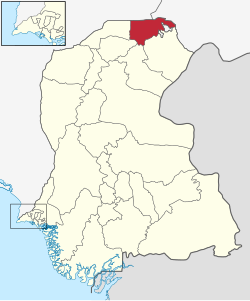Kashmore (District)
| Kashmore District | |
| State : |
|
| Province : | Are |
| Seat : | Kashmore |
| Coordinates : | 28 ° 21 ' N , 69 ° 23' E |
| Area : | 2 592 km² |
| Residents : | 1,089,169 (2017) |
| Population density : | 420 inhabitants per km² |
| Time zone : | PST ( UTC + 5 ) |
| Website : | |

|
|
Kashmore District is an administrative district in Pakistan in Sindh Province . The seat of the district administration is the city of the same name Kashmore .
The district has an area of 2592 km² and according to the 2017 census 1,089,169 inhabitants. The population density is 420 inhabitants / km². The Sindhi language is spoken by the majority in the district .
geography
The Kashmore District is located in the northern part of Sindh and borders Ghotki , Jacobabad , Shikarpur and Sukkur within Sindh . It also borders Balochistan on the western side and Punjab on the eastern side. The Indus flows through the eastern side of the Kashmor district. The Thar Desert is in the east of the district and is home to wild desert animals.
Administrative division
The district is administratively divided into three tehsil :
history
The district was created in 2004 from parts of Jacobabad .
Demographics
Between 1998 and 2017, the population grew at an annual rate of 2.53%. Around 23% of the population live in urban regions and around 77% in rural regions. 564,843 men, 564,843 women and 19 transgender people live in 185,143 households , which results in a gender ratio of 107.7 men per 100 women and thus a common surplus of men for Pakistan.
The literacy rate in the years 2014/15 among the population over 10 years of age was 33% (women: 17%, men: 47%) and thus below the average of the Sindh province of 60%.
| year | population |
|---|---|
| 1972 | 299,589 |
| 1981 | 413,629 |
| 1998 | 677.120 |
| 2017 | 1,089,169 |
Web links
Individual evidence
- ↑ a b DISTRICT WISE CENSUS RESULTS CENSUS 2017. August 29, 2017, accessed May 30, 2019 .
- ↑ Pakistani Districts wise Population Census 2017. Accessed May 30, 2019 .
- ^ Pakistan Bureau of Statistics (2016). Pakistan Social and Living Standards Measurement Survey 2014-15. Government of Pakistan, accessed June 29, 2019 .
